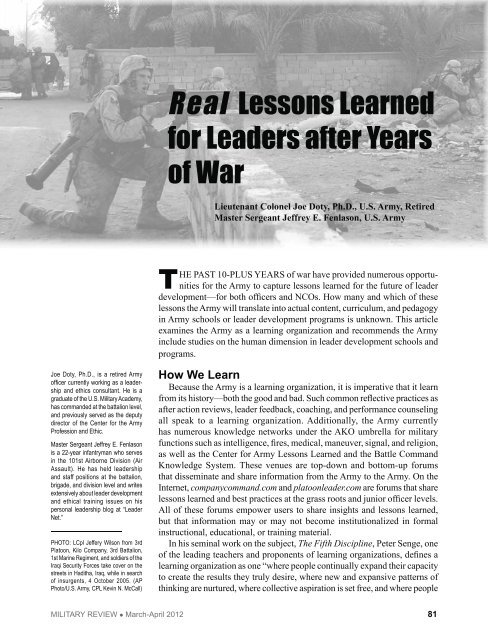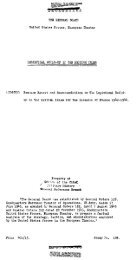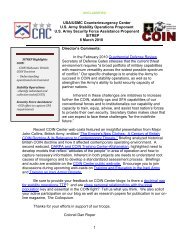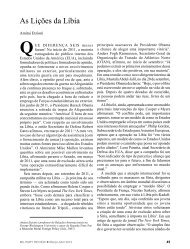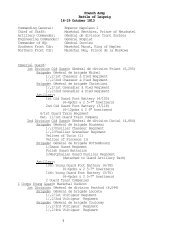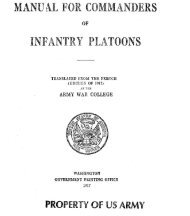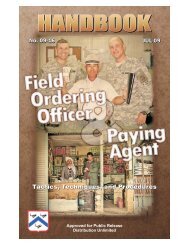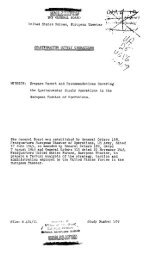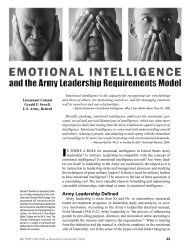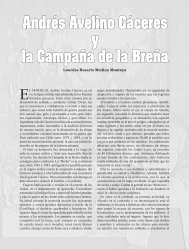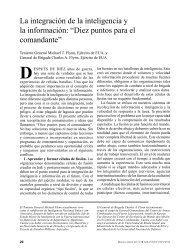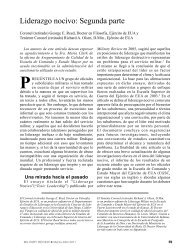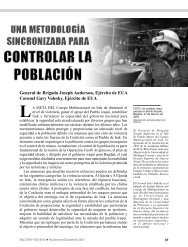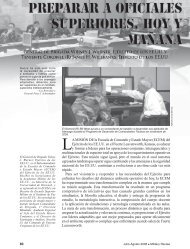Joe Doty - US Army Combined Arms Center and Fort Leavenworth
Joe Doty - US Army Combined Arms Center and Fort Leavenworth
Joe Doty - US Army Combined Arms Center and Fort Leavenworth
You also want an ePaper? Increase the reach of your titles
YUMPU automatically turns print PDFs into web optimized ePapers that Google loves.
Real Lessons Learned<br />
for Leaders after Years<br />
of War<br />
Lieutenant Colonel <strong>Joe</strong> <strong>Doty</strong>, Ph.D., U.S. <strong>Army</strong>, Retired<br />
Master Sergeant Jeffrey E. Fenlason, U.S. <strong>Army</strong><br />
THE PAST 10-PL<strong>US</strong> YEARS of war have provided numerous opportunities<br />
for the <strong>Army</strong> to capture lessons learned for the future of leader<br />
development—for both officers <strong>and</strong> NCOs. How many <strong>and</strong> which of these<br />
lessons the <strong>Army</strong> will translate into actual content, curriculum, <strong>and</strong> pedagogy<br />
in <strong>Army</strong> schools or leader development programs is unknown. This article<br />
examines the <strong>Army</strong> as a learning organization <strong>and</strong> recommends the <strong>Army</strong><br />
include studies on the human dimension in leader development schools <strong>and</strong><br />
programs.<br />
<strong>Joe</strong> <strong>Doty</strong>, Ph.D., is a retired <strong>Army</strong><br />
officer currently working as a leadership<br />
<strong>and</strong> ethics consultant. He is a<br />
graduate of the U.S. Military Academy,<br />
has comm<strong>and</strong>ed at the battalion level,<br />
<strong>and</strong> previously served as the deputy<br />
director of the <strong>Center</strong> for the <strong>Army</strong><br />
Profession <strong>and</strong> Ethic.<br />
Master Sergeant Jeffrey E. Fenlason<br />
is a 22-year infantryman who serves<br />
in the 101st Airborne Division (Air<br />
Assault). He has held leadership<br />
<strong>and</strong> staff positions at the battalion,<br />
brigade, <strong>and</strong> division level <strong>and</strong> writes<br />
extensively about leader development<br />
<strong>and</strong> ethical training issues on his<br />
personal leadership blog at “Leader<br />
Net.”<br />
PHOTO: LCpl Jeffery Wilson from 3rd<br />
Platoon, Kilo Company, 3rd Battalion,<br />
1st Marine Regiment, <strong>and</strong> soldiers of the<br />
Iraqi Security Forces take cover on the<br />
streets in Haditha, Iraq, while in search<br />
of insurgents, 4 October 2005. (AP<br />
Photo/U.S. <strong>Army</strong>, CPL Kevin N. McCall)<br />
How We Learn<br />
Because the <strong>Army</strong> is a learning organization, it is imperative that it learn<br />
from its history—both the good <strong>and</strong> bad. Such common reflective practices as<br />
after action reviews, leader feedback, coaching, <strong>and</strong> performance counseling<br />
all speak to a learning organization. Additionally, the <strong>Army</strong> currently<br />
has numerous knowledge networks under the AKO umbrella for military<br />
functions such as intelligence, fires, medical, maneuver, signal, <strong>and</strong> religion,<br />
as well as the <strong>Center</strong> for <strong>Army</strong> Lessons Learned <strong>and</strong> the Battle Comm<strong>and</strong><br />
Knowledge System. These venues are top-down <strong>and</strong> bottom-up forums<br />
that disseminate <strong>and</strong> share information from the <strong>Army</strong> to the <strong>Army</strong>. On the<br />
Internet, companycomm<strong>and</strong>.com <strong>and</strong> platoonleader.com are forums that share<br />
lessons learned <strong>and</strong> best practices at the grass roots <strong>and</strong> junior officer levels.<br />
All of these forums empower users to share insights <strong>and</strong> lessons learned,<br />
but that information may or may not become institutionalized in formal<br />
instructional, educational, or training material.<br />
In his seminal work on the subject, The Fifth Discipline, Peter Senge, one<br />
of the leading teachers <strong>and</strong> proponents of learning organizations, defines a<br />
learning organization as one “where people continually exp<strong>and</strong> their capacity<br />
to create the results they truly desire, where new <strong>and</strong> expansive patterns of<br />
thinking are nurtured, where collective aspiration is set free, <strong>and</strong> where people<br />
MILITARY REVIEW • March-April 2012<br />
81
are continually learning how to learn together.”<br />
He adds that learning organizations are possible<br />
because—<br />
Not only is it our nature to learn but<br />
we love to learn. . . . Most of us at one<br />
time or another have been part of a great<br />
team, a group of people who functioned<br />
together in an extraordinary way—who<br />
trusted one another, who complemented<br />
one another’s strengths <strong>and</strong> compensated<br />
for one another’s limitations, who<br />
had common goals that were larger than<br />
individual goals, <strong>and</strong> who produced<br />
extraordinary results. . . . The team that<br />
became great didn’t start off great—it<br />
learned how to produce extraordinary<br />
results. 1<br />
Senge proposes that learning organizations<br />
be grounded in “developing three core learning<br />
capabilities: fostering aspiration, developing<br />
reflective conversation, <strong>and</strong> underst<strong>and</strong>ing<br />
complexity.” 2<br />
Nothing in Senge’s thoughts or words is<br />
contradictory to what the <strong>Army</strong> wants to achieve<br />
today or be like in 2025. In fact, Senge’s ideas may<br />
help the <strong>Army</strong> learn more effectively <strong>and</strong> get where<br />
it wants to be in 2025 <strong>and</strong> beyond in terms of real,<br />
intentional, <strong>and</strong> systematic leader development.<br />
What Senge discusses supports our <strong>Army</strong>’s leader<br />
development doctrine, <strong>and</strong> the doctrine supports<br />
what he writes. The <strong>Army</strong> Leader Development<br />
Strategy (ALDS) for a 21st Century <strong>Army</strong> (25<br />
November 2009) calls for a “balanced commitment<br />
to the three pillars of leader development: training,<br />
education, <strong>and</strong> experience . . . our leader development<br />
strategy is part of a campaign of learning. It seeks to<br />
be as adaptive <strong>and</strong> innovative as the leaders it must<br />
develop.” The campaign needs careful, thoughtful<br />
analysis of what constitutes learning <strong>and</strong> how<br />
to achieve it. Three critical aspects of a learning<br />
environment are content or curriculum, pedagogy<br />
(the art <strong>and</strong> science of teaching), <strong>and</strong> the student’s<br />
willingness to learn.<br />
David Kolb’s learning-styles model describes<br />
different ways that individuals learn. All of them<br />
focus on some type of reflective thinking about<br />
what individuals experienced, read, or heard. 3<br />
Kolb’s model is a good starting point to help us<br />
underst<strong>and</strong> that every activity a soldier undertakes<br />
has an experiential element that the soldier becomes<br />
aware of as he reflects <strong>and</strong> thinks about it. In other<br />
words, the soldier “thinks back <strong>and</strong> acts forward.”<br />
Completing the mission is only one part<br />
of a soldier’s requirements in the operational<br />
environment. Thinking back about what happened<br />
<strong>and</strong> using that information <strong>and</strong> knowledge to<br />
influence subsequent actions for the better is another<br />
important requirement, <strong>and</strong> this equates to learning<br />
for performance. The very simple habit-forming<br />
attitude—thinking back <strong>and</strong> acting forward—fosters<br />
aspiration, develops reflective conversations, <strong>and</strong><br />
helps us underst<strong>and</strong> complexity. <strong>Army</strong> stories <strong>and</strong><br />
vignettes often capitalize on this powerful learning<br />
technique. If we make an effort to deliberately <strong>and</strong><br />
habitually reflect as we act, real learning will occur.<br />
Donald Schon’s work on reflective practices<br />
further supports the notion of thinking back <strong>and</strong><br />
acting forward. It discusses organizations that focus<br />
on reflecting (<strong>and</strong> journaling) about experiences to<br />
improve performance. 4 The common denominator<br />
is “systemic reflection” at the individual <strong>and</strong> team<br />
level—a habitual team or individual after action<br />
review in which soldiers <strong>and</strong> leaders make a<br />
conscientious effort to learn so that they will not<br />
repeat mistakes of the past.<br />
New formal instructional material <strong>and</strong> improved<br />
pedagogy for <strong>Army</strong> schools <strong>and</strong> leader development<br />
programs will arise from systemic reflection <strong>and</strong><br />
shared lessons learned. Consider the potential<br />
benefits to the <strong>Army</strong> if all soldiers involved in the<br />
more serious historical incidents in our Nation’s<br />
history had systemically reflected on what they saw,<br />
thought, <strong>and</strong> did, <strong>and</strong> the <strong>Army</strong> had captured <strong>and</strong><br />
catalogued the information they provided to use in<br />
its leader development programs.<br />
Lessons Learned for<br />
Comm<strong>and</strong>ers <strong>and</strong> Leaders<br />
Operation Iraqi Freedom (OIF) <strong>and</strong> Operation<br />
Enduring Freedom (OEF) have provided countless<br />
stories from which to learn. Staff Sergeants Salvatore<br />
Giunta <strong>and</strong> Robert Miller <strong>and</strong> Private First Class<br />
Ross McGinnis displayed selfless service, loyalty,<br />
<strong>and</strong> personal courage, as have countless other<br />
soldiers <strong>and</strong> leaders, named <strong>and</strong> unnamed, who<br />
have set the example, taken the initiative, performed<br />
courageously, <strong>and</strong> chosen the harder right rather than<br />
the easier wrong.<br />
82 March-April 2012 • MILITARY REVIEW
A LEARNING ORGANIZATION<br />
However, as is often the case in human nature,<br />
much learning <strong>and</strong> development comes because of<br />
failures or negative psychological <strong>and</strong> emotional<br />
events. Without question, the vast majority of<br />
soldiers in combat have done, <strong>and</strong> are doing, the<br />
right thing under difficult circumstances—but we<br />
also know that bad things are going to happen—they<br />
always do. And our adversaries will use the media,<br />
the Internet, <strong>and</strong> social networking to cleverly<br />
exploit the slightest misstep by U.S. forces for their<br />
own strategic <strong>and</strong> tactical purposes.<br />
Analysis of the unfortunate <strong>and</strong> tragic U.S.<br />
incidents that have occurred in OIF <strong>and</strong> OEF<br />
provides common themes, insights, <strong>and</strong> lessons<br />
learned (tangible “take-aways”) that leaders should<br />
be aware of <strong>and</strong> look for, both in themselves <strong>and</strong><br />
in their soldiers.<br />
The purpose here is not to—<br />
● Dwell on or highlight the bad stuff.<br />
● Second-guess decisions.<br />
● Criticize with the benefit of hindsight.<br />
● Discuss the personalities involved in the<br />
events.<br />
● Rehash or re-tell the stories.<br />
Our purpose is to help <strong>Army</strong> leaders learn—<br />
really learn. We want to capture <strong>and</strong> articulate what<br />
can, <strong>and</strong> arguably should, be put in leaders’ kit bags<br />
(in this case their hearts <strong>and</strong> brains) in terms of<br />
the human dimension of war to better equip them<br />
to look out for <strong>and</strong> not make the same mistakes<br />
made in the past. We also want to raise awareness<br />
of common themes that have occurred in combat<br />
over the years—<strong>and</strong> will continue for years to come.<br />
What follows are brief summaries of some highprofile<br />
cases from OEF <strong>and</strong> OIF:<br />
The “kill team.” A small group of soldiers in<br />
the 2nd Infantry Division allegedly formed a “kill<br />
team” in late 2009 or early 2010. Some of the team<br />
members allegedly killed two or three unarmed <strong>and</strong><br />
nonthreatening Afghans, then staged the scenes to<br />
make it look as if the deaths were combat related.<br />
They also allegedly committed other violations of<br />
regulations <strong>and</strong> law, such as collecting war trophies<br />
<strong>and</strong> photographing team members with dead bodies.<br />
The Haditha killings. In November 2005 in<br />
Haditha, Iraq, 24 Iraqis were allegedly killed by<br />
U.S. Marines as part of a retribution attack after a<br />
convoy from the 3rd Battalion, 1st Marines, was<br />
hit by an improvised explosive device that killed<br />
U.S. marshals remove former 101st Airborne Division PFC<br />
Steven Dale Green from the courthouse after Green was<br />
sentenced to life in prison, 21 May 2009. Green was convicted<br />
of raping <strong>and</strong> killing an Iraqi teen <strong>and</strong> murdering her family.<br />
Lance Corporal Miguel Terrazas <strong>and</strong> severely<br />
wounded another marine. At least three officers were<br />
officially reprim<strong>and</strong>ed for failing to properly report<br />
<strong>and</strong> investigate the killings. All criminal charges<br />
against six marines were dropped <strong>and</strong> one marine<br />
was prosecuted <strong>and</strong> found not guilty. The squad<br />
leader was recently given a plea deal <strong>and</strong> found guilty<br />
of negligent dereliction of duty.<br />
The canal killings. Three noncommissioned<br />
officers from the 172nd Brigade Combat Team<br />
were found guilty of executing four Iraqi detainees<br />
on or around April 2007. These “canal killings”<br />
(as they were called on a CNN documentary about<br />
them) were allegedly a response to detainees being<br />
released—after having been detained only a few<br />
days—<strong>and</strong> immediately returning to the fight.<br />
Samarra murders. Four soldiers from the 101st<br />
Airborne Division (Air Assault) were found guilty of<br />
killing three detainees in May 2006 during Operation<br />
Iron Triangle near Samarra, Iraq. Allegedly, the<br />
(AP Photo/ Daniel R. Patmore)<br />
MILITARY REVIEW • March-April 2012<br />
83
soldiers released the detainees <strong>and</strong> then shot them<br />
to make it look like an escape attempt.<br />
Tigris River bridge incident. In January 2004,<br />
soldiers from the 4th Infantry Division allegedly<br />
forced two Iraqis off a bridge over the Tigris River.<br />
One of the Iraqis died. An officer <strong>and</strong> an NCO were<br />
found guilty of crimes related to this incident (assault<br />
<strong>and</strong> obstruction of justice). During the investigation<br />
it was alleged that the battalion comm<strong>and</strong>er wanted<br />
to cover up the bridge incident.<br />
Mahmudiya murders <strong>and</strong> rape. In March 2006,<br />
near Mahmudiya, Iraq, four soldiers from the 101st<br />
Airborne Division (Air Assault) killed four Iraqi<br />
noncombatants <strong>and</strong> raped one of them before killing<br />
her. All four soldiers were found guilty of rape <strong>and</strong><br />
murder.<br />
Abu Ghraib. Eleven soldiers were found guilty<br />
of detainee abuse <strong>and</strong> other crimes in connection<br />
with this well-publicized case in Abu Ghraib prison,<br />
Iraq.<br />
Bagram detainee abuse. In the spring <strong>and</strong><br />
summer of 2002, at Bagram Air Base, Afghanistan,<br />
soldiers were allegedly involved in detainee abuse<br />
cases, which were featured on a CNN documentary,<br />
“Taxi to the Dark Side.” At least 15 personnel were<br />
charged with crimes <strong>and</strong> five were convicted.<br />
The eight incidents briefly described above,<br />
along with others from all conflicts (most notably<br />
the My Lai incident in Vietnam in 1968) highlight<br />
what can happen in war. Clearly, the incidents are<br />
not a reflection of our <strong>Army</strong>, our professional ethic,<br />
or the seven <strong>Army</strong> Values. In addition, they may not<br />
be examples of leadership failures.<br />
They do indicate a need for increased leader<br />
education about indicators of ethics abdication.<br />
Additionally, we must face the reality that the<br />
military is a reflection of society, <strong>and</strong> one of the<br />
incidences—the rape <strong>and</strong> murder at Mahmudiya,<br />
Iraq—was likely in part a result of a criminal<br />
element within the ranks.<br />
Most important from a learning perspective is the<br />
fact that the incidents were a result of some, if not<br />
all, of nine psychological <strong>and</strong> emotional constructs<br />
that can be a consequence of a stressful, complex,<br />
uncertain, <strong>and</strong> highly volatile combat environment.<br />
The nine constructs are:<br />
Authorization. Authorization is the perception<br />
that the chain of comm<strong>and</strong> sanctions, approves,<br />
or directs a particular behavior, i.e., “I was just<br />
following orders,” or “This is what my leaders want/<br />
expect me to do.”<br />
Transfer of responsibility. Transfer of<br />
responsibility is the perception that some other<br />
person bears the responsibility for an unethical act,<br />
i.e., “Someone else is responsible.”<br />
Rountinization. Routinization occurs when<br />
soldiers gradually acculturate to unethical actions<br />
or abuses. Unethical behavior simply becomes<br />
routine, i.e., “It’s just what we do.” An athlete who<br />
has taken performance enhancing drugs for years or<br />
teenagers paying for one movie <strong>and</strong> watching two<br />
or three in a cineplex are civilian examples. The<br />
routine <strong>and</strong> daily execution of the “final solution”<br />
by Nazi Germany during World War II is history’s<br />
most horrendous example of routinitization.<br />
Dehumanization/disqualification. These occur<br />
when soldiers lose respect for others or think that<br />
others are “below them.” Soldiers may feel like<br />
they are being forced to protect or help people who<br />
are not like them <strong>and</strong> who they do not like. During<br />
the Vietnam War, use of the derogatory terms<br />
“gooks” or “slopes” indicated that some soldiers<br />
had dehumanized the local people.<br />
Moral disengagement. Moral disengagement<br />
occurs when soldiers are so physically, mentally,<br />
psychologically, <strong>and</strong> emotionally stressed <strong>and</strong><br />
exhausted that they cognitively disengage from<br />
moral <strong>and</strong> ethical reasoning or simply do not<br />
think about it. This usually takes the form of<br />
some kind of self-deception (lying to themselves),<br />
rationalization (the ends justifies the means), or<br />
even “mindlessness” or “mind-numbing.” It often<br />
results in routinization of unethical behaviors.<br />
In some cases, a soldier may simply not think in<br />
terms of right <strong>and</strong> wrong or may not be thinking<br />
at all—just acting without thinking.<br />
Bracketed morality. Bracketed morality refers<br />
to a soldier assigning a different set of values<br />
or beliefs in one context (for example, while<br />
deployed) as opposed to another (while back “in<br />
the world”). Or, put another way, “What happens<br />
in theater stays in theater.” 5<br />
Misplaced loyalty. This refers to a soldier<br />
placing his loyalty to other soldiers (battle<br />
buddies) or the small unit higher than the<br />
organization’s values—the Seven <strong>Army</strong> Values. A<br />
soldier committing an unethical act to take care of<br />
or cover for a squad mate is an example.<br />
84 March-April 2012 • MILITARY REVIEW
A LEARNING ORGANIZATION<br />
Peer pressure. Peer pressure is the influences<br />
of the group or unit that can override a soldier’s<br />
ability to act or think individually (a lack of moral<br />
courage).<br />
Groupthink. Groupthink is similar to peer<br />
pressure when the weight of the group’s ideas<br />
overrides the soldier’s ability to think <strong>and</strong> act alone<br />
(a lack of moral courage).<br />
Some of the constructs above can act alone on<br />
a soldier’s thinking <strong>and</strong> emotional well-being,<br />
although they normally work in combination.<br />
When several of these constructs in combination<br />
influence a soldier, bad things may happen.<br />
Arguably, all nine of them influenced soldier<br />
<strong>and</strong> leader actions at My Lai <strong>and</strong> at Abu Ghraib.<br />
Some or all played a significant role in the other<br />
incidents. Although there are volumes of academic<br />
research on these constructs, they really are not<br />
complicated for <strong>Army</strong> leaders to underst<strong>and</strong> or<br />
identify. 6 <strong>Army</strong> comm<strong>and</strong>ers <strong>and</strong> leaders, both<br />
officers <strong>and</strong> NCOs, are intelligent, educated, <strong>and</strong><br />
well-meaning professionals. Their awareness of<br />
“what can happen” may be all it takes to help<br />
mitigate these threats. More important from the<br />
leader development perspective is that these<br />
psychological <strong>and</strong> emotional threats should be<br />
known <strong>and</strong> understood by comm<strong>and</strong>ers <strong>and</strong><br />
leaders. They should discuss them at comm<strong>and</strong> <strong>and</strong><br />
staff meetings <strong>and</strong> during after action reviews <strong>and</strong><br />
integrate them into predeployment training. Even<br />
more dogmatically, they could be checklist items<br />
for leaders to carry with them.<br />
The nine constructs are human issues. The<br />
<strong>Army</strong> is in the business of leading human<br />
beings—individual, emotive, thoughtful, distinct<br />
people. No two are the same. You cannot produce<br />
the exact same model of them on an assembly<br />
line year after year. No rigid “scientific method”<br />
will influence people to accomplish the mission.<br />
Training soldiers—<strong>and</strong> developing them into<br />
leaders—is the work of thoughtful craftsmen, not<br />
the processing of thous<strong>and</strong>s of parts that come<br />
together to complete the organization. Because<br />
individual free will exists, friction, uncertainty,<br />
psychological interaction, <strong>and</strong> chance will also<br />
exist. Combat leaders must underst<strong>and</strong> the<br />
complex nature of human beings.<br />
The statements below, taken from investigations<br />
<strong>and</strong> discussions of the incidents above <strong>and</strong> others,<br />
… psychological <strong>and</strong> emotional<br />
threats should be known <strong>and</strong><br />
understood by comm<strong>and</strong>ers <strong>and</strong><br />
leaders.<br />
are examples of what leaders should listen for as<br />
signs that a soldier may be suffering from some of<br />
these threats:<br />
“He displayed pure hatred for the enemy <strong>and</strong><br />
often referred to them as savages.”<br />
“Are we going to protect the population or kill<br />
insurgents?”<br />
“When the world you thought was made of<br />
concrete turns out to be smoke <strong>and</strong> mirrors, the<br />
results can be devastating.”<br />
“I don’t care if I die.”<br />
“We are undermanned <strong>and</strong> no one gives a damn.”<br />
“Certain people are not to come back alive.”<br />
“The <strong>Army</strong> has great leaders <strong>and</strong> morally<br />
bankrupt leaders.”<br />
“I challenge you to imagine the frustration felt<br />
after being engaged in firefights for several hours<br />
with the enemy <strong>and</strong> then capturing them, only to<br />
have them released two days later because you’re<br />
told the holding area needs more information on<br />
them.”<br />
“Don’t tell them about _____.”<br />
“The climate in the unit was toxic.”<br />
“We repeatedly found ourselves fighting the<br />
same enemy again <strong>and</strong> again.”<br />
“Kill all military-aged males on the objective.”<br />
“We need more kills.”<br />
Of course, these quotes must be taken in context.<br />
As st<strong>and</strong>-alone quotes, they may have a negative or<br />
threatening meaning, while in context, they may not<br />
mean a problem exists at all. Context matters. But<br />
if a leader hears remarks like the ones just above,<br />
his radar screen should blip with a cautionary note<br />
<strong>and</strong> he should start asking probing questions. In<br />
addition, leaders should look out for soldiers who<br />
behave erratically or anti-socially. For example, a<br />
soldier torturing or killing dogs <strong>and</strong> cats would be<br />
an obvious warning sign.<br />
Interestingly (<strong>and</strong> coincidentally) after the My<br />
Lai incident, Lieutenant General William Peers’<br />
MILITARY REVIEW • March-April 2012<br />
85
investigation found nine factors that influenced that<br />
tragic event:<br />
● Lack of proper training.<br />
● Attitude toward the local people (lack of cultural<br />
sensitivity).<br />
● Permissive attitude.<br />
● Psychological factors.<br />
● Organizational factors.<br />
● Nature of the enemy.<br />
● Plans, orders, <strong>and</strong> comm<strong>and</strong>er’s intent.<br />
● Attitude of the government officials.<br />
● Leadership. 7<br />
The same psychological constructs that were<br />
the proximate cause of My Lai are still a threat to<br />
our soldiers <strong>and</strong> leaders <strong>and</strong> will always be. From a<br />
learning perspective, the nine constructs previously<br />
discussed are a subset of the nine factors found at<br />
My Lai–the attitude toward the locals, psychological<br />
factors, the nature of the enemy, plans <strong>and</strong> orders, <strong>and</strong><br />
leadership. This dates back to 1968 <strong>and</strong> highlights the<br />
need to learn, really learn, from the past. Of course,<br />
atrocities by U.S. soldiers have occurred throughout<br />
U.S. wars to include during World War II with the<br />
killing of German prisoners at Dachau, Germany. 8<br />
They also include the killing of German <strong>and</strong> Italian<br />
prisoners at Biscari, Italy. 9 These historical examples<br />
are powerful reminders of how the dark side of<br />
warfare can influence soldiers’ <strong>and</strong> leaders’ thoughts,<br />
emotions, <strong>and</strong> behaviors.<br />
Other Recommendations<br />
Other curriculum additions we propose involve<br />
contextual <strong>and</strong> environmental challenges (as opposed<br />
to psychological constructs) that soldiers <strong>and</strong> leaders<br />
might experience while deployed. Teaching <strong>and</strong><br />
discussing these <strong>and</strong> others challenges will better<br />
prepare future combat leaders for some of the<br />
challenges they could face. This list of challenges is<br />
certainly not complete:<br />
● Winning tactically but losing operationally or<br />
strategically.<br />
● Reporting of events—truthful or otherwise.<br />
● Corruption <strong>and</strong> bribes.<br />
● Contractors in the battlespace.<br />
● Lack of resources.<br />
● Unrealistic expectations in an area of operations.<br />
● Comm<strong>and</strong>ers out of touch with reality at lower<br />
levels.<br />
● Soldiers stretched too thin.<br />
Some challenges on this list are clearly outside the<br />
average private to staff sergeant’s thought process<br />
<strong>and</strong> influence. In fact, squad leaders <strong>and</strong> even platoon<br />
sergeants <strong>and</strong> platoon leaders may have very little<br />
influence over most of these things—but leaders at<br />
all levels should be aware of them. Other challenges<br />
leaders will have to be cognizant of <strong>and</strong> likely address<br />
include—<br />
● Decisions regarding escalation of force.<br />
● Dropping or planting weapons.<br />
● War trophies.<br />
● Revenge motives.<br />
● The need to control their own <strong>and</strong> their soldiers’<br />
emotions.<br />
● The attitude of “If no one talks, no one will<br />
find out.”<br />
These are the kinds of things that a squad leader,<br />
platoon sergeant, or platoon leader can directly<br />
control. They are individual leader challenges—<br />
but also comm<strong>and</strong>er issues—<strong>and</strong> influenced by<br />
comm<strong>and</strong> climate. The leader has to recognize when<br />
soldiers feel threatened <strong>and</strong> determine when he<br />
needs to resort to an escalation of force. The leader<br />
chooses (or allows subordinates to choose) to carry<br />
a spare weapon on patrol to drop next to a shooting<br />
victim to make it appear the patrol was fired upon.<br />
Leaders create a reality that justifies their actions<br />
when deployed. Leaders allow soldiers to give in to<br />
lesser instincts <strong>and</strong> succumb to blood lust. Leaders<br />
allow killing for revenge. Clearly, the <strong>Army</strong> does<br />
not condone these things, nor does it equivocate<br />
that they might be permitted in some circumstances.<br />
These are first <strong>and</strong> foremost individual choices <strong>and</strong><br />
must be seen that way. But strong, educated, <strong>and</strong><br />
knowledgeable leaders <strong>and</strong> leadership can influence<br />
individual choices.<br />
Leaders must be able to—<br />
● Recognize a noncombatant.<br />
● Underst<strong>and</strong> the risks to <strong>and</strong> treatment of noncombatants.<br />
● Recognize <strong>and</strong> know the risks to legally protected<br />
sites.<br />
● Provide a clear comm<strong>and</strong>er’s intent.<br />
● Identify a questionable comm<strong>and</strong> climate.<br />
● Know when to intervene to stop wrongdoing<br />
of others.<br />
All of these things should be addressed by the<br />
institution <strong>and</strong> the comm<strong>and</strong>—these are leader<br />
issues. Contextually they all begin with comm<strong>and</strong><br />
86 March-April 2012 • MILITARY REVIEW
A LEARNING ORGANIZATION<br />
climate <strong>and</strong> are all about leaders being able to<br />
control their own <strong>and</strong> their soldiers’ emotions. First,<br />
the leader must master self-awareness <strong>and</strong> selfmanagement,<br />
<strong>and</strong> then look at things in a political<br />
<strong>and</strong> emotional context. Only when he has mastered<br />
that can he set the tone that will address the other<br />
items (noncombatants, risk, historically protected<br />
sites, <strong>and</strong> other responsibilities).<br />
From a pedagogical perspective in a school<br />
environment or officer <strong>and</strong> noncommissioned officer<br />
professional development program, leaders could<br />
analyze <strong>and</strong> discuss real vignettes while integrating<br />
the nine constructs recommended within a case<br />
study methodology. This technique would require<br />
researching the facts of each case, then discussing<br />
the human dimension aspects in context. The<br />
challenge with this case study technique would be<br />
ensuring that the real personalities involved in the<br />
stories are removed from the learning environment<br />
unless the actual knowledge of the personalities<br />
involved enhances the learning experience. The<br />
goal of the sessions should be real learning—not<br />
“protection of reputations.” Students could reflect on<br />
<strong>and</strong> discuss insights <strong>and</strong> lessons learned from their<br />
knowledge, experiences, <strong>and</strong> underst<strong>and</strong>ing of the<br />
cases. Of course, integrating similar vignettes into<br />
pre-deployment scenarios <strong>and</strong> training would also<br />
be an effective technique of learning from the past<br />
<strong>and</strong> enhancing leader development for the future.<br />
Real Learning via Self-Awareness<br />
<strong>and</strong> Self-Management<br />
Learning, growing, <strong>and</strong> developing are life-long<br />
choices that individuals <strong>and</strong> organizations make—<br />
they don’t just happen. Being a life-long learner<br />
is a conscious choice that requires a high level of<br />
self-awareness <strong>and</strong> self-management. 10 Leaders<br />
need to be self-aware enough to know both what<br />
they do know <strong>and</strong> what they do not know, <strong>and</strong> when,<br />
where, <strong>and</strong> what they need to learn. For example,<br />
life-long learners must be self-aware enough to<br />
know that they lack knowledge in some areas, <strong>and</strong><br />
then take the steps to learn or improve in those<br />
areas—self-management. The leaders who think<br />
they know it all or have nothing else to learn are<br />
setting up themselves, their units, <strong>and</strong> their missions<br />
for failure—or worse. We have introduced some<br />
specific topics we feel leaders need to know in a<br />
combat environment.<br />
For professionally grounded leaders to underst<strong>and</strong>,<br />
learn, <strong>and</strong> adapt, they must also intentionally <strong>and</strong><br />
habitually practice self-management, which should<br />
(U.S. Air Force,TSGT Manuel J. Martinez)<br />
U.S. soldiers serving with the 10th Special Forces Group gather at <strong>Fort</strong> Walton Beach, FL, 1 March 2011, before a water<br />
training mission during Emerald Warrior 2011. Emerald Warrior is an annual two-week joint/combined tactical exercise<br />
designed to leverage lessons learned from operations to provide trained <strong>and</strong> ready forces to combatant comm<strong>and</strong>ers.<br />
MILITARY REVIEW • March-April 2012<br />
87
flow directly from being self-aware (of note, one can<br />
be self-aware without self-managing). The leaders,<br />
being consciously aware of what <strong>and</strong> how they are<br />
thinking (meta-cognition) <strong>and</strong> feeling, must then<br />
regulate those thoughts <strong>and</strong> feelings to best fit the<br />
context they are experiencing. Self-managing leaders<br />
must effectively focus <strong>and</strong> control their thinking <strong>and</strong><br />
emotions to better control themselves <strong>and</strong> lead their<br />
soldiers. Being more knowledgeable <strong>and</strong> aware of the<br />
human dimension <strong>and</strong> the concepts <strong>and</strong> constructs<br />
we have introduced can only make for better leaders.<br />
<strong>Army</strong> leaders primarily lead people, not<br />
organizations, <strong>and</strong> the development <strong>and</strong> underst<strong>and</strong>ing<br />
of people (the human dimension) should be a<br />
fundamental purpose of all leader development<br />
programs—as is being tactically <strong>and</strong> technically<br />
proficient. Equally important, leaders should be in<br />
programs to study themselves (to develop <strong>and</strong> practice<br />
self-awareness)—who they are, what formed them,<br />
how they think, why they think that way, <strong>and</strong> the<br />
potential consequences of decisions based on their<br />
thought processes <strong>and</strong> mental models. 11<br />
We recommend making self-awareness a focus<br />
of leader development. Our contention is that by<br />
concentrating a large part of our efforts inward, we<br />
will develop leaders of known moral character, with<br />
the ability to critically view their environment<br />
(including their soldiers), look out for common<br />
threats in the human dimension, <strong>and</strong> make decisions<br />
consistent with the values of the nation <strong>and</strong> the<br />
<strong>Army</strong> <strong>and</strong> that advance the comm<strong>and</strong>er’s intent<br />
<strong>and</strong> mission. Real leader development begins with<br />
one’s self. 12<br />
The more knowledge of human behavior <strong>and</strong><br />
the human dimension leaders have, the more<br />
they will underst<strong>and</strong> <strong>and</strong> potentially influence<br />
it. Firm knowledge of the psychological <strong>and</strong><br />
emotional constructs <strong>and</strong> recurring themes we have<br />
recommended can be a start point. For example,<br />
leaders’ thoughts <strong>and</strong> emotions may drive them<br />
to seek some kind of irrational revenge after the<br />
tragic loss of some of their soldiers to an immoral<br />
adversary. How (<strong>and</strong> if) leaders regulate this<br />
revenge motive (both cognitively <strong>and</strong> emotionally)<br />
will affect their decision cycle, their ethical<br />
reasoning, <strong>and</strong> ultimately their behavior.<br />
Notably, the <strong>Army</strong>’s Comprehensive Soldier<br />
Fitness project with the University of Pennsylvania<br />
to enhance resilience in soldiers <strong>and</strong> their families<br />
is a wonderful <strong>and</strong> effective means to teach selfawareness<br />
<strong>and</strong> self-management. 13 A significant<br />
portion of the project stems from the university’s<br />
psychology department <strong>and</strong> attempts to teach<br />
emotion regulation, impulse control, <strong>and</strong> causal<br />
analysis. These three skills are classic examples of<br />
self-awareness <strong>and</strong> self-regulation. For example,<br />
the “ABC” (activation event, belief, consequences),<br />
“avoid thinking traps” (errors in thinking), <strong>and</strong><br />
“detect icebergs” (deep-seated mental models) skills<br />
teach the student how to practice self-awareness <strong>and</strong><br />
self-regulation. 14 Leaders who are knowledgeable<br />
of the threats <strong>and</strong> constructs we have discussed <strong>and</strong><br />
can habitually practice the Comprehensive Soldier<br />
Fitness skills will more effectively underst<strong>and</strong><br />
themselves, control their thoughts <strong>and</strong> behaviors,<br />
lead their soldiers, mitigate threats, ensure ethical<br />
behaviors, <strong>and</strong> accomplish the mission.<br />
Summary<br />
In combat, leaders must be aware of the many<br />
negative psychological <strong>and</strong> emotional effects that<br />
the stresses <strong>and</strong> violence of combat may have<br />
on their soldiers: the nine constructs we have<br />
discussed. Sound pedagogy <strong>and</strong> planned training<br />
throughout our <strong>Army</strong> can educate, train, <strong>and</strong><br />
develop our leaders to—<br />
● Recognize threatening signs in their soldiers.<br />
● Recognize threatening signs in themselves.<br />
● Ethically reason.<br />
● Recognize an ethical situation that may not<br />
be self-evident.<br />
The <strong>Center</strong> for the <strong>Army</strong> Profession <strong>and</strong> Ethic is<br />
addressing these last two areas. Self-aware leaders<br />
should habitually ask themselves <strong>and</strong> their trusted<br />
subordinates if there are any unhealthy signs or<br />
indicators in their units. Self-aware comm<strong>and</strong>ers<br />
should also habitually ask their subordinates what<br />
ethical challenges their units are facing or may<br />
face in the future.<br />
If this ability or knowledge requires a checklist,<br />
so be it. The material for the checklist <strong>and</strong> the<br />
curriculum is based on years of lessons learned<br />
from our <strong>Army</strong>—a learning organization. Given<br />
the strategic environment in terms of operations in<br />
Afghanistan <strong>and</strong> Iraq, the time seems right to focus<br />
on <strong>and</strong> improve our leader-development schools<br />
<strong>and</strong> programs. We have proposed some specific<br />
content to assist in that effort. MR<br />
88 March-April 2012 • MILITARY REVIEW
A LEARNING ORGANIZATION<br />
(U.S. Air Force, SSGT Jonathan Lovelady)<br />
U.S. soldiers with the 4th Battalion, 10th Special Forces Group secure their jump gear <strong>and</strong> prepare to board a U.S. Air Force<br />
KC-130 Hercules aircraft at the John C. Stennis Space <strong>Center</strong> in Mississippi, 8 March 2011, during Emerald Warrior 2011.<br />
NOTES<br />
1. Peter Senge, The Fifth Discipline: The Art <strong>and</strong> Practice of the Learning<br />
Organization (New York: Doubleday, 1990).<br />
2. Ibid.<br />
3. David Kolb, Experiential Learning: Experience as the Source of Learning <strong>and</strong><br />
Development (Upper Saddle, NJ: Prentice Hall, Inc., 1984).<br />
4. Donald Schon, The Reflective Practitioner: How Professionals Think in Action<br />
(New York: Basic Books, Inc., 1983).<br />
5. Joseph <strong>Doty</strong> <strong>and</strong> Shawn Tenace, “What Goes on in Theater Stays in Theater?”<br />
<strong>Army</strong> Magazine, January 2009.<br />
6. For example, K. Aquino <strong>and</strong> A. Reed, “The Self-importance of Moral Identity,”<br />
Journal of Personality <strong>and</strong> Social Psychology, 83(6) (1999): 1423-30; Albert B<strong>and</strong>ura,<br />
“Moral Disengagement in the Perpetration of Inhumanities,” Personality <strong>and</strong> Social<br />
Psychology Review, (3)3 (1999): 193-209; Albert B<strong>and</strong>ura, Self-Efficacy: The Exercise<br />
of Control (New York: Cambridge University Press, 1995); J. Bargh, “Automatic <strong>and</strong><br />
Conscious Process of Social Information,” in R.S. Wyer & T.K. Stull, eds., H<strong>and</strong>book<br />
of Social Cognition, Vol 3 (Hillsdale, NJ: Erlbaum, 1984), 1-44.<br />
7. LTG William Peers, The My Lai Inquiry (New York <strong>and</strong> London: W.W. Norton<br />
<strong>and</strong> Company, 1979).<br />
8. Howard Buchner, Dachau: The Hour of the Avenger: An Eyewitness Account<br />
(Metairie, Thunderbird Press, Inc., 1986).<br />
9. James Weingartner, “Massacre at Biscari: Patton <strong>and</strong> an American War Crime,”<br />
The Historian, 52(1) (1989): 24-39.<br />
10. We define self-awareness as habitually <strong>and</strong> intentionally monitoring one’s<br />
thoughts (meta-cognition or thinking about how one is thinking), feelings, emotions,<br />
<strong>and</strong> behaviors. We define self-management as habitually <strong>and</strong> intentionally controlling<br />
one’s thoughts, feelings, emotions, <strong>and</strong> behaviors.<br />
11. Senge.<br />
12. Bruce Avolio, Leadership Development in Balance: Made/Born (Mahwah,<br />
NJ: Erlbaum, 2005).<br />
13. George Casey, “Comprehensive Soldier Fitness: A Vision for Psychological<br />
Resilience in the United States <strong>Army</strong>,” in M. Seligman <strong>and</strong> M. Matthews, eds.,<br />
American Psychologist (Special Issue on Comprehensive Soldier Fitness), 66(1)<br />
(2011): 1-3.<br />
14. K. Reivich, <strong>and</strong> A. Shatte, The Resilience Factor: Seven Essential Skills for<br />
Overcoming Life’s Inevitable Obstacles (New York: Broadway Books, 2002).<br />
MILITARY REVIEW • March-April 2012<br />
89


